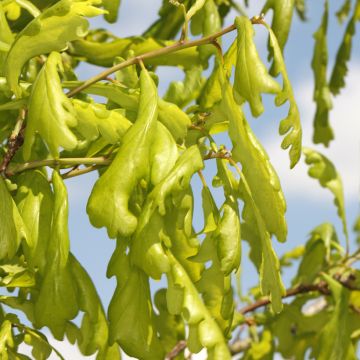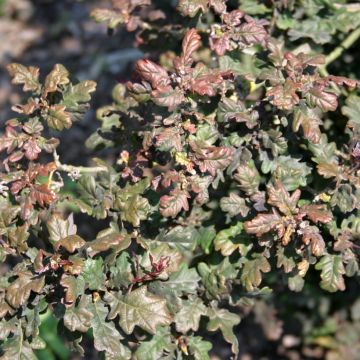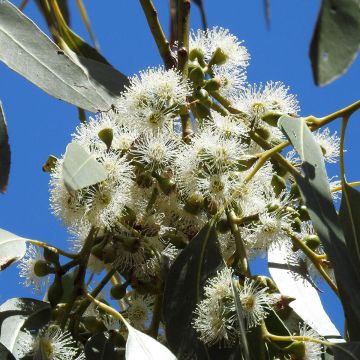

Quercus robur Purpurascens - English Oak
Quercus robur Purpurascens - English Oak
Quercus robur Purpurascens
English Oak, Common Oak, Pedunculate Oak
Special offer!
Receive a €20 voucher for any order over €90 (excluding delivery costs, credit notes, and plastic-free options)!
1- Add your favorite plants to your cart.
2- Once you have reached €90, confirm your order (you can even choose the delivery date!).
3- As soon as your order is shipped, you will receive an email containing your voucher code, valid for 3 months (90 days).
Your voucher is unique and can only be used once, for any order with a minimum value of €20, excluding delivery costs.
Can be combined with other current offers, non-divisible and non-refundable.
Why not try an alternative variety in stock?
View all →This plant carries a 24 months recovery warranty
More information
We guarantee the quality of our plants for a full growing cycle, and will replace at our expense any plant that fails to recover under normal climatic and planting conditions.
Would this plant suit my garden?
Set up your Plantfit profile →
Description
Quercus robur 'Purpurescens' (synonym sanguinea) is a very beautiful cultivar of the Pedunculate Oak, with purple foliage and young branches. Extremely colourful, its foliage is traversed by light and takes on very rich shades of red, brown, and violet. Its young leaves, strongly tinted with red-purple at budbreak, gradually turn brown before turning greenish-purple in summer. This large contrasting tree will find its place in a large garden. It is perfectly adapted to most of our temperate regions. It only requires light, slightly chalky, fertile, and moist soil to thrive.
The Pedunculate Oak, also known as the English oak, male oak, or gravelin, belongs to the Fagaceae family. It is native to a large part of temperate Europe. It thrives in sub-oceanic to oceanic climates, or relatively humid continental climates without excesses. In its natural environment, it can reach a height of 50 m (164 ft) with a spread of 25 m to 30 m (82 ft to 98.4 ft), while its trunk can measure up to 2 m (6.6 ft) in diameter. With a quite exceptional longevity, this oak can live up to 2000 years according to some estimates.
The 'Purpurascens' cultivar will reach an average maturity of 15 m (49.2 ft) in all directions. The growth of this oak is moderately fast. Its habit is generally rounded. The trunk is quite short and is covered with a thick and deeply fissured grey and dark bark. Its young branches are glabrous and shiny, of a purple colour. The late deciduous foliage is composed of alternate, soft, obovate leaves that can reach 5 cm to 15 cm (2 in to 5.9 in) in length and 3 cm to 8 cm (1.2 in to 3.1 in) in width. Each leaf is divided into 5 to 7 pairs of asymmetrical rounded lobes, separated by relatively deep sinuses. The base of the lamina is narrow and has 2 small lobes. The colour of the lamina evolves from red to reddish-brown, then to greenish-purple, with the lower surface being paler. The leaves become brown, quite late in autumn, and remain somewhat attached to the branches before falling. The flowering of this oak occurs in April-May, shortly after the appearance of the foliage, on the annual shoots. The female flowers, yellow-green in colour, are placed in a cupule carried by a long peduncle: this distinctive characteristic is the origin of the species name, pedunculata. The male inflorescences are elongated, pendant catkins, tinged with yellow. They are produced on older branches. The female flowers give way to ovoid and elongated acorns, 1.5 cm to 3 cm (0.6 in to 1.2 in) long. They are often grouped in pairs or threes and attached to a long peduncle. A cupule covered with scales covers one-third of the acorn. The colour evolves from green to brown at maturity, in September and October. The root system of this tree is deep and powerful, both taproot and widely spreading, ensuring a solid and durable anchorage in deep and compact soils.
'Purpurascens', a contrasting tree, will become one of the masterpieces of a natural or even contemporary garden large enough to accommodate it. In spring, a graceful ballet of red to purple young leaves takes place, turning while they unfold from brown to greenish-purple, a shade to be associated with the golden foliage of the 'Concordia' variety, golden honey locust (Gleditsia triacanthos 'Sunburst'), the silver of the white willow (Salix alba) and the white poplar (Populus alba 'Nivea'), as well as the blue flowers of Sophora davidii or arborescent ceanothus. It can be planted either in isolation or in alignment. It also has the advantage of providing pleasant shade, which reflects light in winter, and producing abundant compost, which is favourable to the growth of certain plants that germinate under its cover. Its fruits, sometimes produced in abundance, nourish small animals such as squirrels and jays.
Quercus robur Purpurascens - English Oak in pictures


Plant habit
Flowering
Foliage
Botanical data
Quercus
robur
Purpurascens
Fagaceae
English Oak, Common Oak, Pedunculate Oak
Cultivar or hybrid
Other Oak
View all →Planting and care
Quercus robur 'Purpurascens' grows in ordinary but deep soil, preferably clayey, slightly calcareous, neutral or slightly acidic. Once established, this tree with deep anchoring can withstand normal summers and does not require any watering. This oak succeeds almost everywhere, except in coastal areas. It appreciates moist but well-drained soils, where its growth will be faster. It prefers very sunny and well-cleared exposures. Place a sturdy stake to help it start, water at first and then let nature take its course. It requires very little maintenance except for the removal of dead wood. It is not very susceptible to diseases, but powdery mildew can affect its foliage.
Planting period
Intended location
Care
Planting & care advice
This item has not been reviewed yet - be the first to leave a review about it.
Similar products
Haven't found what you were looking for?
Hardiness is the lowest winter temperature a plant can endure without suffering serious damage or even dying. However, hardiness is affected by location (a sheltered area, such as a patio), protection (winter cover) and soil type (hardiness is improved by well-drained soil).

Photo Sharing Terms & Conditions
In order to encourage gardeners to interact and share their experiences, Promesse de fleurs offers various media enabling content to be uploaded onto its Site - in particular via the ‘Photo sharing’ module.
The User agrees to refrain from:
- Posting any content that is illegal, prejudicial, insulting, racist, inciteful to hatred, revisionist, contrary to public decency, that infringes on privacy or on the privacy rights of third parties, in particular the publicity rights of persons and goods, intellectual property rights, or the right to privacy.
- Submitting content on behalf of a third party;
- Impersonate the identity of a third party and/or publish any personal information about a third party;
In general, the User undertakes to refrain from any unethical behaviour.
All Content (in particular text, comments, files, images, photos, videos, creative works, etc.), which may be subject to property or intellectual property rights, image or other private rights, shall remain the property of the User, subject to the limited rights granted by the terms of the licence granted by Promesse de fleurs as stated below. Users are at liberty to publish or not to publish such Content on the Site, notably via the ‘Photo Sharing’ facility, and accept that this Content shall be made public and freely accessible, notably on the Internet.
Users further acknowledge, undertake to have ,and guarantee that they hold all necessary rights and permissions to publish such material on the Site, in particular with regard to the legislation in force pertaining to any privacy, property, intellectual property, image, or contractual rights, or rights of any other nature. By publishing such Content on the Site, Users acknowledge accepting full liability as publishers of the Content within the meaning of the law, and grant Promesse de fleurs, free of charge, an inclusive, worldwide licence for the said Content for the entire duration of its publication, including all reproduction, representation, up/downloading, displaying, performing, transmission, and storage rights.
Users also grant permission for their name to be linked to the Content and accept that this link may not always be made available.
By engaging in posting material, Users consent to their Content becoming automatically accessible on the Internet, in particular on other sites and/or blogs and/or web pages of the Promesse de fleurs site, including in particular social pages and the Promesse de fleurs catalogue.
Users may secure the removal of entrusted content free of charge by issuing a simple request via our contact form.
The flowering period indicated on our website applies to countries and regions located in USDA zone 8 (France, the United Kingdom, Ireland, the Netherlands, etc.)
It will vary according to where you live:
- In zones 9 to 10 (Italy, Spain, Greece, etc.), flowering will occur about 2 to 4 weeks earlier.
- In zones 6 to 7 (Germany, Poland, Slovenia, and lower mountainous regions), flowering will be delayed by 2 to 3 weeks.
- In zone 5 (Central Europe, Scandinavia), blooming will be delayed by 3 to 5 weeks.
In temperate climates, pruning of spring-flowering shrubs (forsythia, spireas, etc.) should be done just after flowering.
Pruning of summer-flowering shrubs (Indian Lilac, Perovskia, etc.) can be done in winter or spring.
In cold regions as well as with frost-sensitive plants, avoid pruning too early when severe frosts may still occur.
The planting period indicated on our website applies to countries and regions located in USDA zone 8 (France, United Kingdom, Ireland, Netherlands).
It will vary according to where you live:
- In Mediterranean zones (Marseille, Madrid, Milan, etc.), autumn and winter are the best planting periods.
- In continental zones (Strasbourg, Munich, Vienna, etc.), delay planting by 2 to 3 weeks in spring and bring it forward by 2 to 4 weeks in autumn.
- In mountainous regions (the Alps, Pyrenees, Carpathians, etc.), it is best to plant in late spring (May-June) or late summer (August-September).
The harvesting period indicated on our website applies to countries and regions in USDA zone 8 (France, England, Ireland, the Netherlands).
In colder areas (Scandinavia, Poland, Austria...) fruit and vegetable harvests are likely to be delayed by 3-4 weeks.
In warmer areas (Italy, Spain, Greece, etc.), harvesting will probably take place earlier, depending on weather conditions.
The sowing periods indicated on our website apply to countries and regions within USDA Zone 8 (France, UK, Ireland, Netherlands).
In colder areas (Scandinavia, Poland, Austria...), delay any outdoor sowing by 3-4 weeks, or sow under glass.
In warmer climes (Italy, Spain, Greece, etc.), bring outdoor sowing forward by a few weeks.



































































